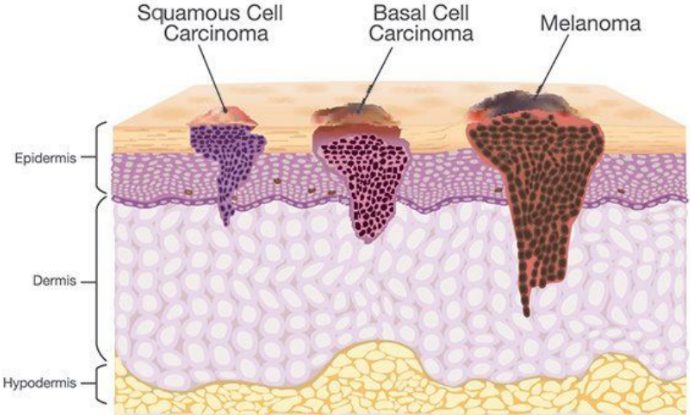
INFORMATION
Types of Skin Cancer
Skin cancer is the most common type of cancer in Australia and occurs when skin cells are damaged by the overexposure to ultraviolet (UV) radiation from the sun.
Every year in Australia, more than 13,000 Australians are diagnosed with a melanoma and almost 980,000 of non-melanoma skin cancers are treated. It is mostly treatable when detected early on.
(https://www.healthdirect.gov.au/skin-cancer-and-melanomas)
There are three types of skin cancer
1. Basal cell carcinoma – most common
2. Squamous cell carcinoma
3. Melanoma – the most dangerous form of skin cancer
01. Basal cell carcinoma
Basal cell carcinoma is the most common, least dangerous type of skin cancer. They arise from basal cells located in the top skin layer (epidermis). This type of skin cancer usually develops in sun-exposed areas such as the face, ears, neck and upper body.
WHAT TO LOOK OUT FOR
• A pinkish patch which is usually flat and persists
• A pinkish lump which may be shiny or pearly
• A sore that does not heal
• A spot that bleeds easily
• A scar like area or thickening that slowly grows
02. Squamous cell carcinoma
This is the second most common type of skin cancer and develops from squamous cells located on the outermost layer of the skin (epidermis).
These skin cancers often develop on the head, neck, face, forearms, hands, and are usually the result of long term ultraviolet (UV) light exposure.
If left untreated, squamous cell carcinoma can continue to spread to other parts of the body.
WHAT TO LOOK OUT FOR
• Pinkish or red scaly patch
• Raised white crusty lump, which may be painful when pressed
03. Melanoma
This is the least common but most dangerous form of skin cancer as it is more likely to spread. Melanoma arises from uncontrolled growth of melanocytes, the pigment producing cells located at the bottom part of the top skin layer (epidermis). These cells also cause freckles and moles (many of which are harmless) where they grow in a controlled fashion. Having a large number of moles is a melanoma risk factor.
WHAT TO LOOK OUT FOR
• Asymmetry
• Borders that are irregular
• Changing spots or unusual colours
• Different to the other spots on the skin
Am I At Risk?
There are a few key things to look out for when it comes to the causes of skin cancers in Australia: • Fair skin type • Excessive sun exposure • Have many moles on your body • Spend a lot of time outdoors due to activities or work • Family history of skin cancer • Having a past of skin cancer yourself • Medical conditions, compromised immune system • Taking immunosuppression medication • Have used solariums
Prevention
It is crucial to ensure you are protecting yourself from the sun when the UV level is 3 or above using the following measures: • Wear sunscreen – apply an SPF 30 or higher to your face and body before going outside. Reapply every two hours or after swimming or excessive sweating. • Wear protective clothing – sun-protective clothing that covers as much skin as possible. • Wear a broad-rim hat to protect your face, head, neck and ears and sunglasses that meet the Australian standards. • Seek shade between the hours of 10am and 4pm (when the UV rays are most harmful). • Do not get sunburnt. • Avoid tanning and never use UV tanning beds (solariums). • Self-check your skin and keep an eye on any spots that potentially change in colour / appearance. • Book an annual skin check with Mole Mapping WA to stay on top of any potential risks – early detection is the best protection!
Sources
02. Melanoma Institute Australia
https://melanoma.org.au/about-melanoma/what-is-melanoma



